For everyone who has already seen “Hell or High Water”, you know the Oscar race has begun thanks to an award-worthy performance by Jeff Bridges, a powerhouse script from Taylor Sheridan and stunning cinematography by Giles Nuttgens. This film has Best Picture contender written all over it. (And if you haven’t seen “Hell or High Water”, get thee to a theatre now!) But this week another contender in the acting race steps into the Oscar ring with Jonathan Jakubowicz’ HANDS OF STONE and two knockout performances from Edgar Ramirez and, potential Oscar nominee, Robert DeNiro. HANDS OF STONE is 15 rounds of glorious filmmaking.
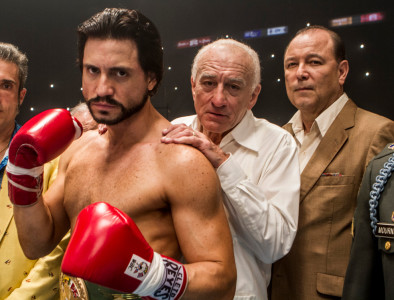
A biopic on one of the greatest (if not the greatest) lightweight boxers in history, Roberto Duran, writer/director Jonathan Jakubowicz’ takes us not only into the ring, but into the streets of Panama to tell the story of the rise – and fall – of Roberto Duran. But as part and parcel to Duran’s story is that of legendary boxing trainer Ray Arcel.
Any boxing fan knows the legend that is Ray Arcel. One of the most celebrated trainers in boxing history, during a 60+ year career Arcel trained 22 world champions, and generally by using strategy and intelligence as opposed to just pugilistic pummeling. Unfortunately, Arcel was drummed out of boxing in 1956 by the East Coast mobs because of his vision for taking boxing national through television. To make their point, in 1953 Arcel was attacked from behind, struck in the head with a lead pipe wrapped in a paper bag. Rebounding from near death, this incident and rumored threats of further attack should he continue to work and make money in boxing, forced him to leave the sport he so loved; that is until 1972 when Roberto Duran’s manager Carlos Eleta asked Arcel to train his fighter Alfonso “Peppermint” Frazer for a world title. Arcel agreed and then after Frazer won, Eleta asked Arcel to take a look at Duran.
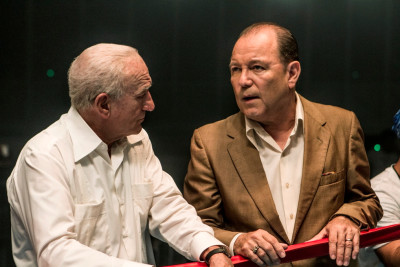
And then there’s Robert Duran. A young man who grew up in poverty in the slums of El Chorrillo in Panama, Duran started working in the streets at age five or six, shining shoes, selling newspapers, washing dishes and even showing off some fancy footwork dancing in the streets for money, all of which he gave to his mother to help feed the family. Growing up in the Canal Zone imbued within young Duran a growing hatred for America thanks not only to the economic disparity between the U.S. controlled areas and laws and the poverty-stricken Panamanians, but he was also more than a bit disgruntled with Americans given his father was in the U.S. Army and stationed in the Canal Zone, but disappeared when his tour of duty ended when Roberto was just five months old. By age eight, Roberto was already channeling his anger in the boxing ring as a sparring partner at the now-called Neco de la Guardia gym.
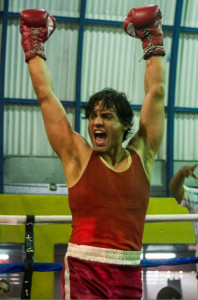
Taking literary license and fictionalizing some aspects of the Arcel and Duran stories, Jakubowicz crafts a winning story that melds the well known statistics, stories and images in the ring and in front of the cameras with the unseen backstories of both men. Working closely with Robert DeNiro, who first met Ray Arcel when he was in the midst of “Raging Bull”, Arcel’s widow Stephanie, and Roberto Duran himself, the resonance of each character and their respective essence and voice is brought to life by Edgar Ramirez and Robert DeNiro.
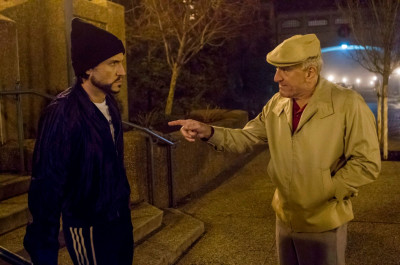
As Roberto Duran, Edgar Ramirez is spellbinding – especially in the third act as Duran goes into the party hearty lifestyle after becoming world champ and the inner emotional turmoil that ensues. Never believing that Ramirez could surpass the range and emotional power of his performance in “The Liberator”, he is beyond impressive here. Be it from delivering and embodying childlike innocence in pursuit of a girl, or being a kid at heart with ice cream bribery after each fight, to an omnipresent peacock strut, swagger and explosive confidence bordering on arrogance, with each emotional shift, each movement, Ramirez rings true. As we follow Duran’s boxing trajectory, Ramirez brings a bratty defiance to the man, but after Duran loses to Sugar Ray Leonard and he finally realizes what truly drives him as a man, there is a confident maturity that is riveting. Neither your eyes nor your heart can look away.
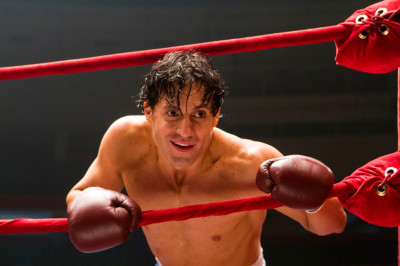
And then get Ramirez in the ring. WOW! Training with Roberto Duran himself, as well as Duran’s son, and working with boxing choreographer Rob Sale, Edgar Ramirez shows himself to have the true “eye of the tiger” and heart of a boxer. His movements are solid, punches beyond believable and effective as notable Duran bouts are recreated, leading up to the two most significant against Sugar Ray Leonard. Ramirez’ face screams conflict, pain, confusion. . . especially in the ring with the Leonard re-match and then against Moore as Duran tries to make a comeback. The conviction and longing need for Arcel’s appearance, Arcel’s approval after Arcel hung up his training gloves, is heartwrenching. I’m warning you – bring tissues.
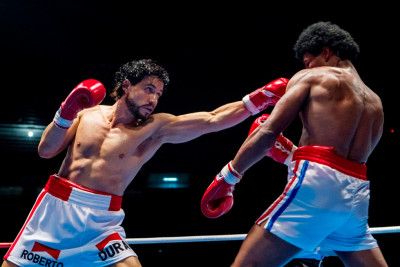
I can honestly say, I have never enjoyed DeNiro more than in the past 7 years or so. He wears life well and infuses it into each and every character with raw honesty. As Ray Arcel, he steals your heart. Weinstein Company needs to start his Oscar campaign now. While the film is technically about Roberto Duran, the richer and deeper story lies with Ray Arcel and with DeNiro’s performance. In a sport with a storied history of showboating, backroom deals and boxers taking dives, Arcel is the moral compass and voice of decency and intelligence. DeNiro embodies this with every utterance, every movement, every look. The devil is truly in the details as DeNiro gets under Arcel’s skin with nuance and truth. Adding to the performance is the real life dynamic not only between Duran and Arcel, but Ramirez and DeNiro. You see and feel the father-son relationship develop and take hold, adding another layer to the emotional tapestry.
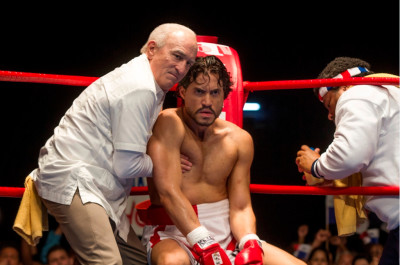
One of the two biggest surprises of HANDS OF STONE is Usher Raymond. Scene-stealing as Sugar Ray Leonard, Usher is a refreshing surprise and plays up the razzle dazzle for which Leonard was known both in and out of the ring. The other surprise is a very subdued John Turturro as mob boss Frankie Carbo. With quiet controlled hushed monotones, hiding behind thick rimmed glasses, it is that very control that imbues one with fear and trepidation over what’s lurking in the shadows. Very effective.
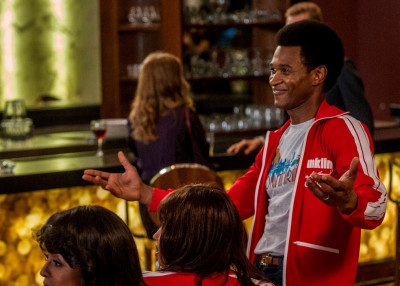
Let’s just say “hell yes” to actors capturing the essence and voice of “Humble” Howard Cosell and Don King. Robb Skyler is a dead on Cosell while Reg E. Cathey delivers a mind-boggling braggadocios Don King! Ellen Barkin easily tackles the role of Stephanie Arcel serving as Devil’s Advocate and sounding board to DeNiro’s Ray. Nice pairing of the two.
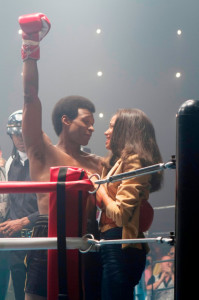
Structurally, the story is well crafted but for a couple of time jumps that aren’t clear. There is nothing surprising in the trajectory of the story as Jakubowicz adheres pretty closely to the real life timeline of Duran and Arcel. The meld of politics and sport, particularly as a driving force for Duran, while never getting preachy, is exemplary. The life parallels between Arcel and Duran are poignantly explored while lovely metaphor takes shape with the almost serendipitous relationship between the two.
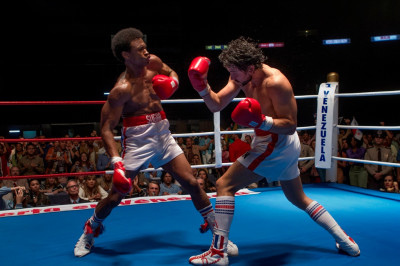
Drawing us into the mindset of Duran and his life is the intensity of the lensing by cinematographer Miguel Ioann Littin Menz and the frenetic rapid-fire editing of Ethan Maniquis, the latter whom sweeps us into a frenzy where time passes in the blink of an eye and the click of a camera defines a moment in time. The synergy of Menz and Maniquis astounds, and never moreso than in the boxing matches. 360 dutching is off the charts insane!

Which leads us to Rob Sale, simply the best boxing technician/fight choreographer for film ever (outside of perhaps Stallone). Sale knows boxing, and particularly the specific fights and styles of the 1960-1990 era (which he brought to “Grudge Match” with Stallone and DeNiro and a fight sequence employing footwork of an Ali-Frazier fight), as does fight choreographer/stunt coordinator and 2nd unit director Rick Avery, so the grace and beauty of the pugilism we see unfold here, especially with Ramirez and Usher, is not only spot on, but thanks to Menz’ lensing, riveting. We are in the moment. We feel each punch, each shake of a beaten head, each shaky footstep thrown off balance. Thanks to Roberto Duran himself and his son who trained Ramirez, and Sugar Ray Leonard who worked with Usher, many of the fights are as close to replication as possible.
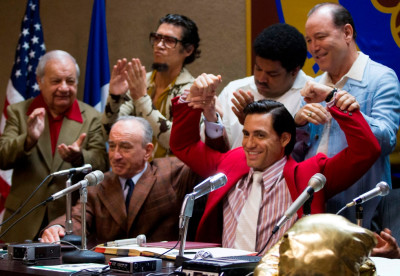
Menz’ lensing with the use of close-ups with both Ramirez and DeNiro is raw intensity at its most potent. The overall visual tonal bandwidth with lighting – along with color and vibrancy of the Panamanian spirit – is almost celebratory and screams life. Night shots are gorgeous while day is often a vibrant kaleidoscope of color.

With any biopic, there are inherent challenges to the storytelling given the iconic individuals and documented visual history and here is no different. As a boxing fan of the 60’s, 70’s and 80’s, not to mention old school boxing history, while Jakubowicz smartly includes recreations of iconic images and fight techniques, he keenly focuses on the unseen images of Duran’s life in Panama and that behind the camera, letting the audience see Duran’s generosity with his fellow Panamanians, serving almost as Robin Hood to the community. Here again, the importance of editing and creating that metaphoric whirlwind of time passing in the blink of an eye is key to the momentum of the film and the emotional ride.
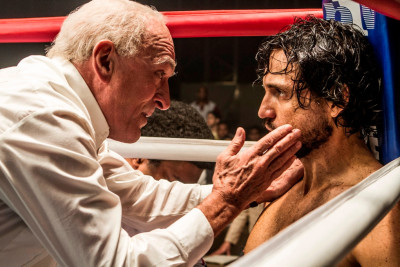
Angelo Milli’s scoring is intricate with a nice fusion of f tunes of the day, Panamanian flavor, and pop culture.
Although it’s a split decision with a few rounds of the storytelling, HANDS OF STONE goes the distance for the win.
Written and Directed by Jonathan Jakubowicz
Cast: Edgar Ramirez, Robert DeNiro, Usher Raymond IV, John Turturro, Ellen Barkin












